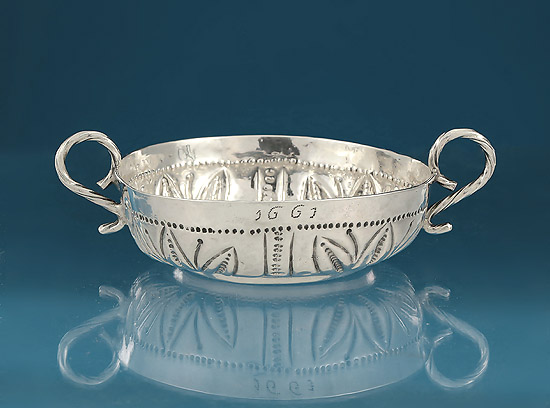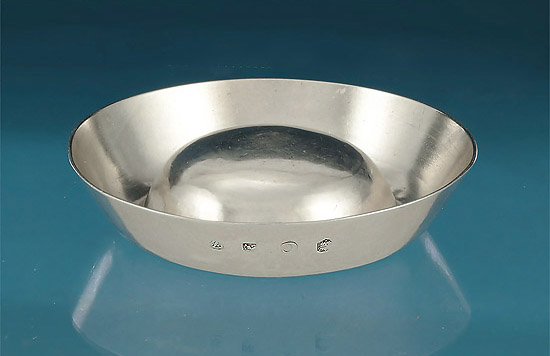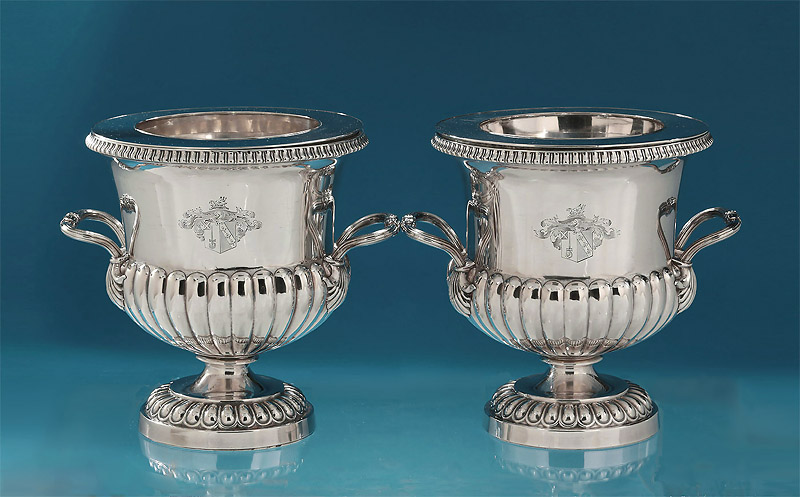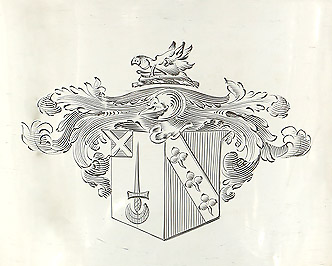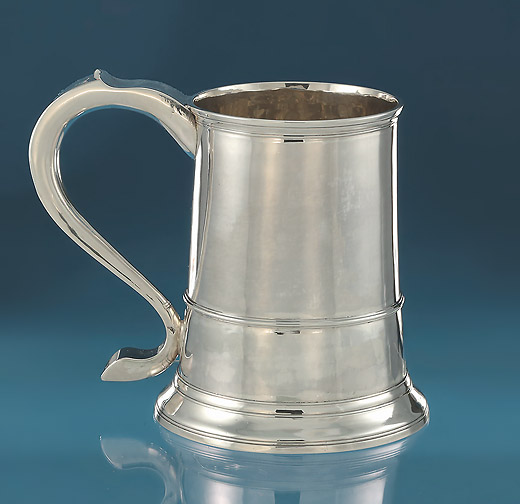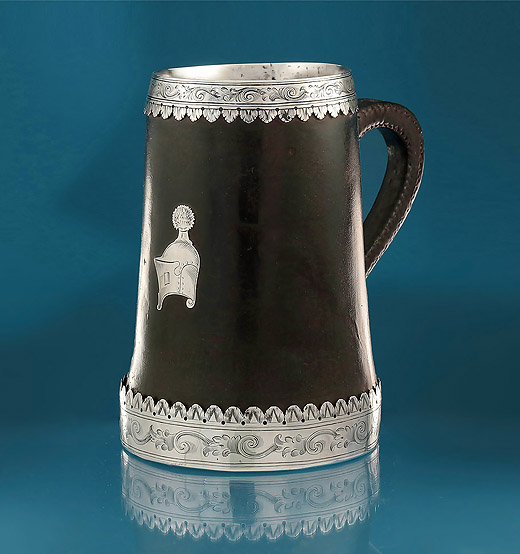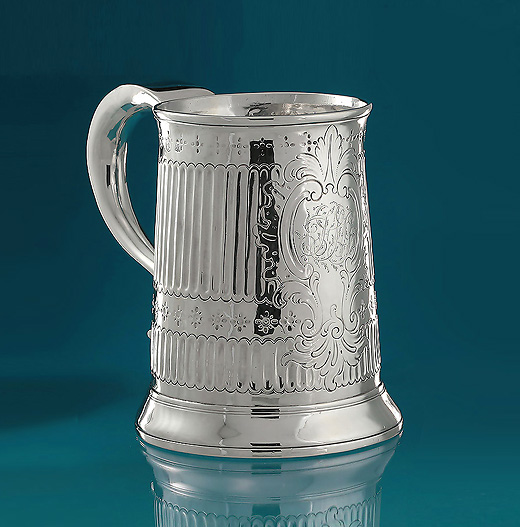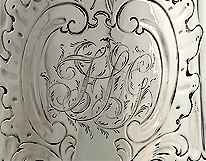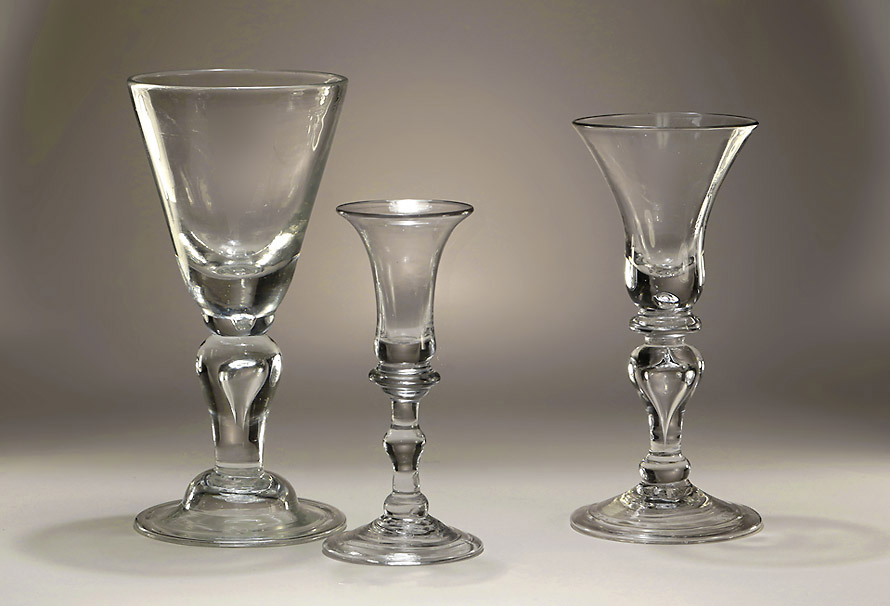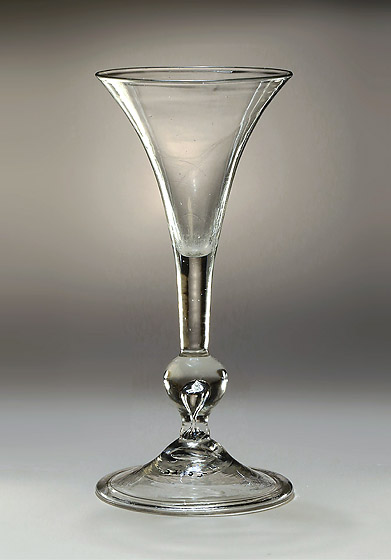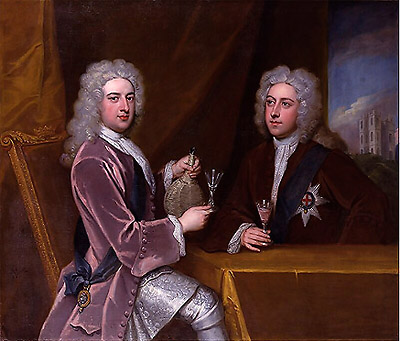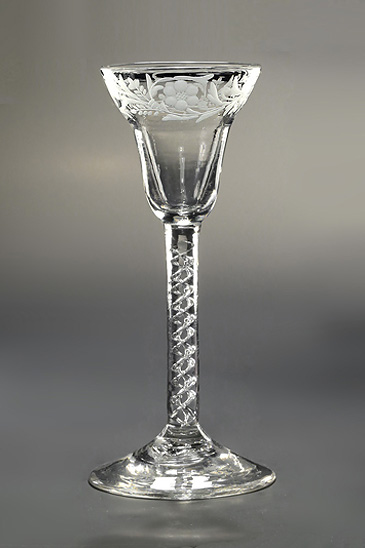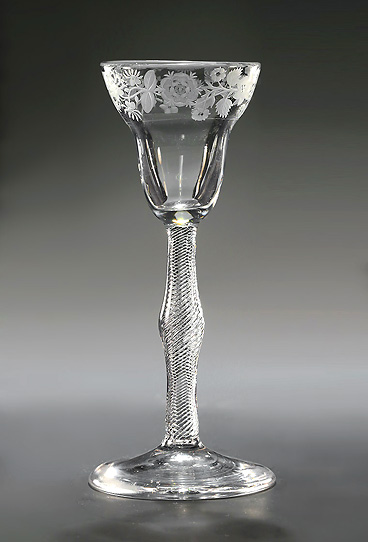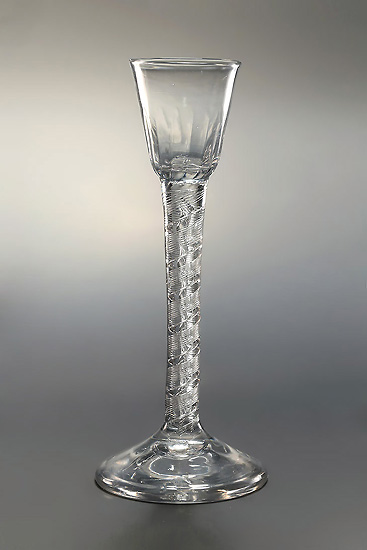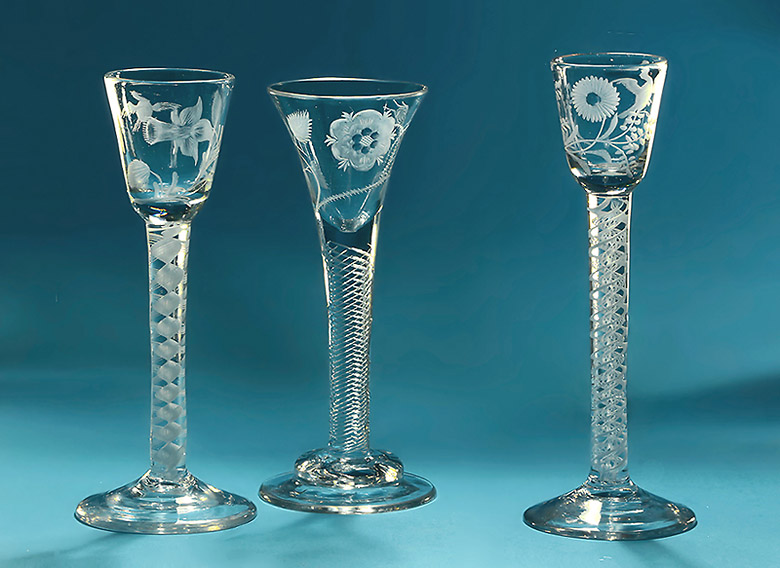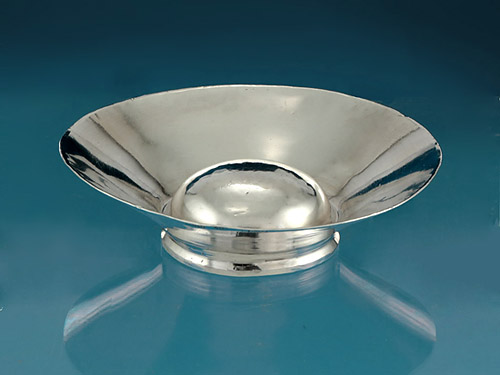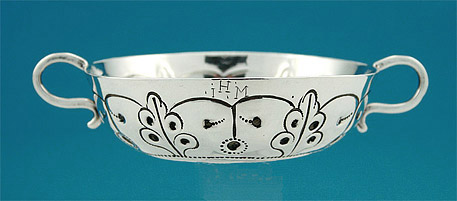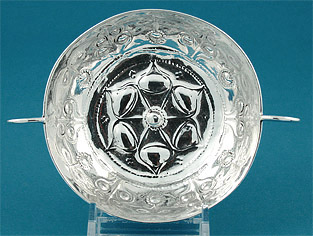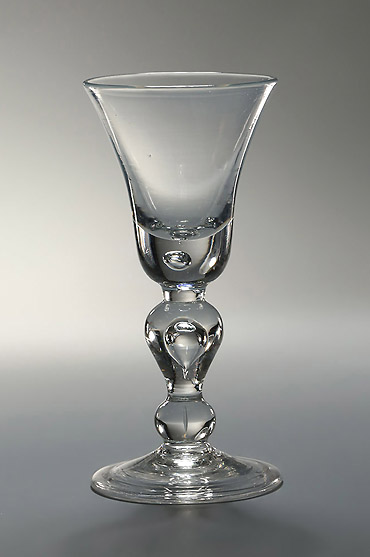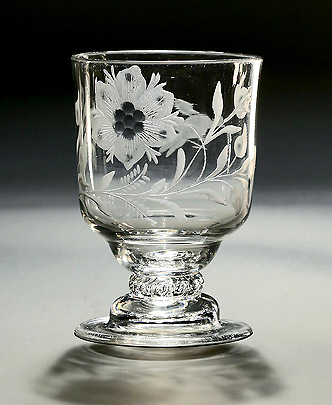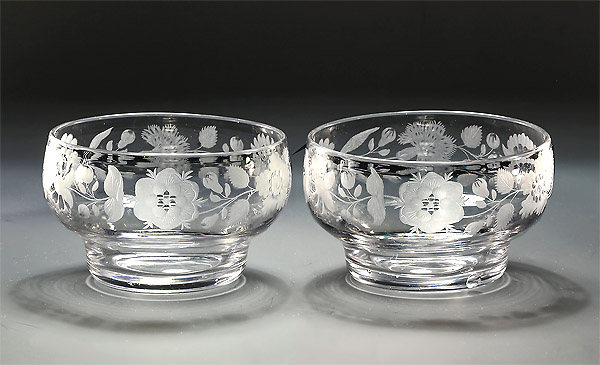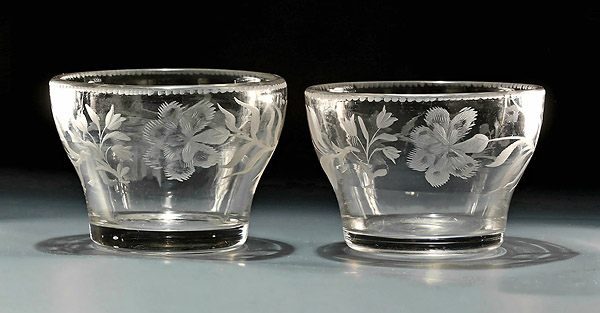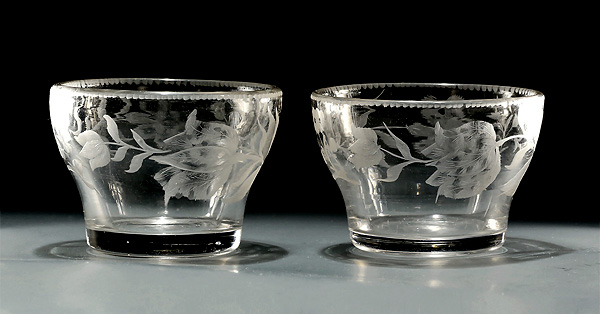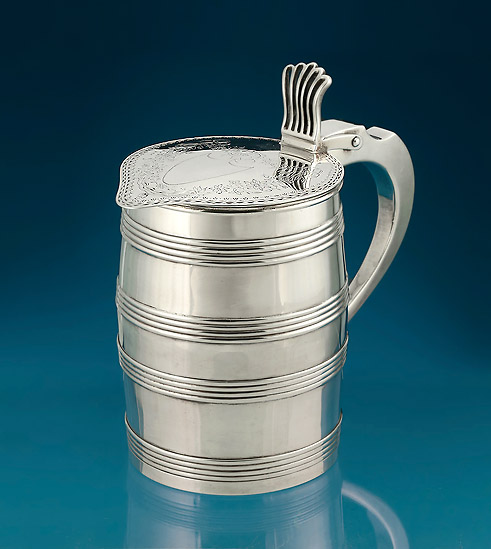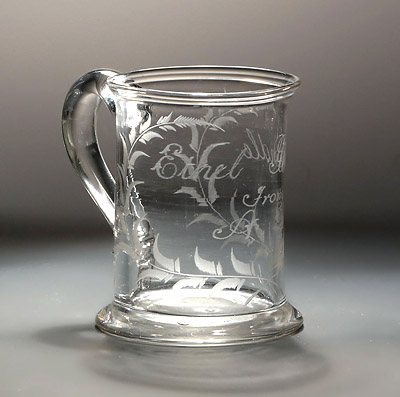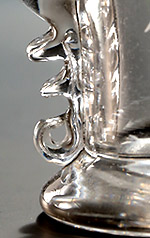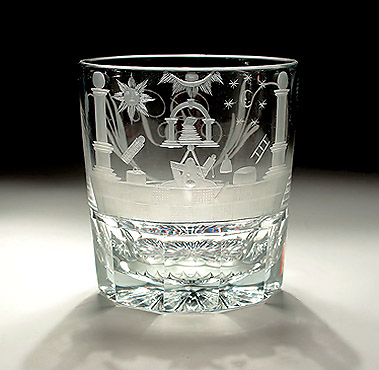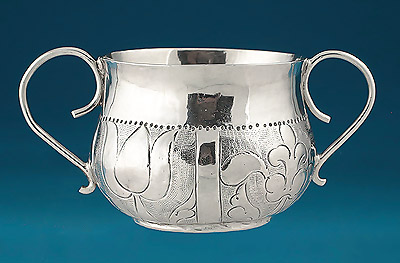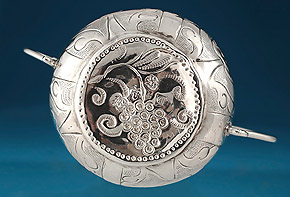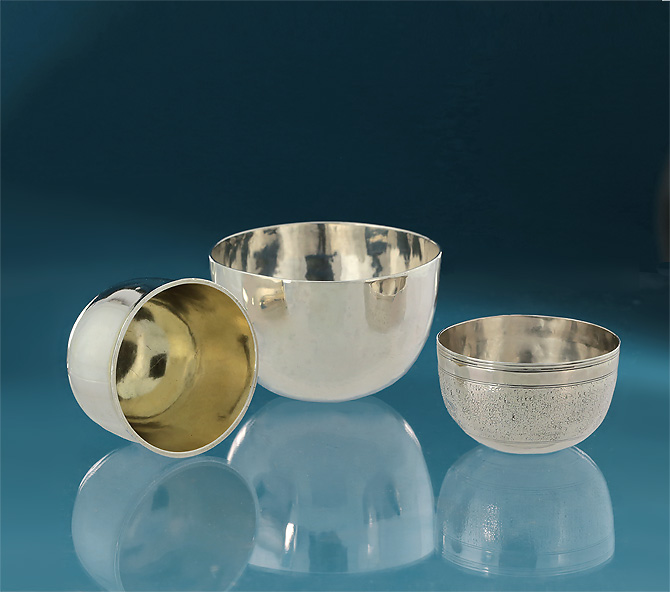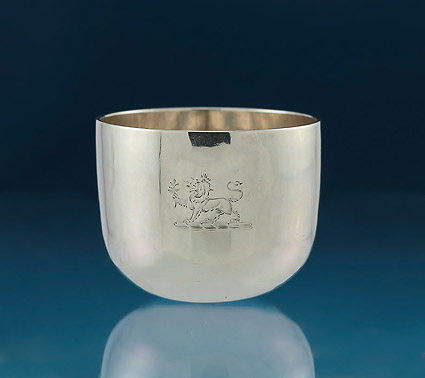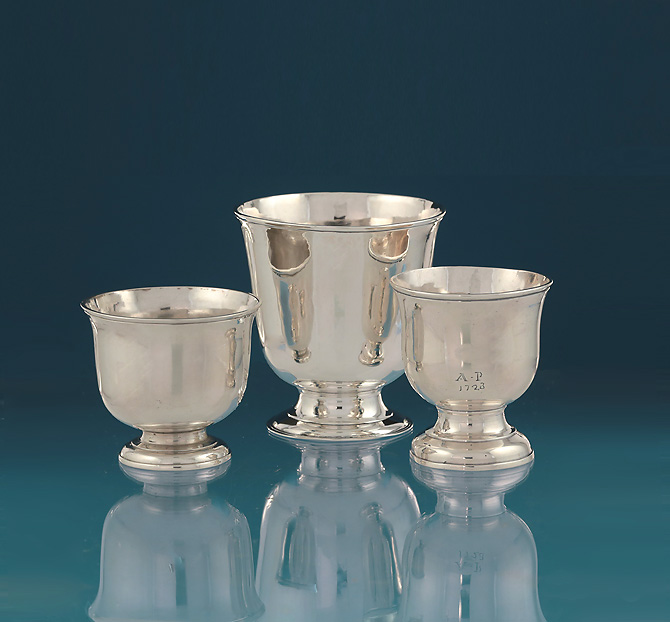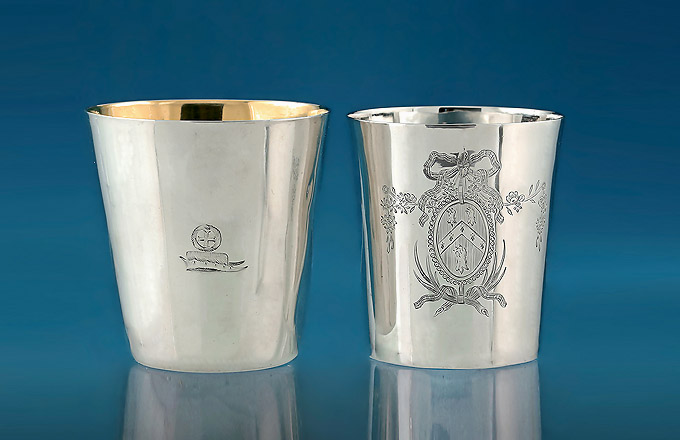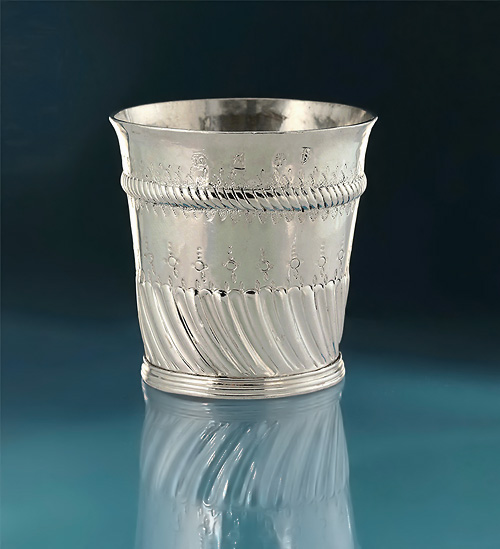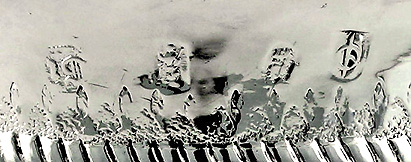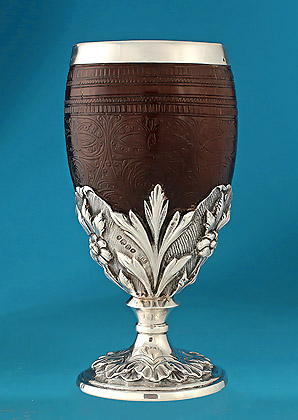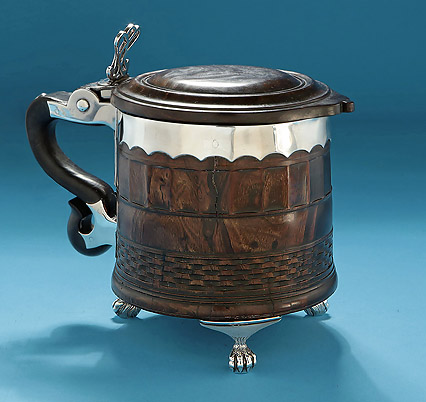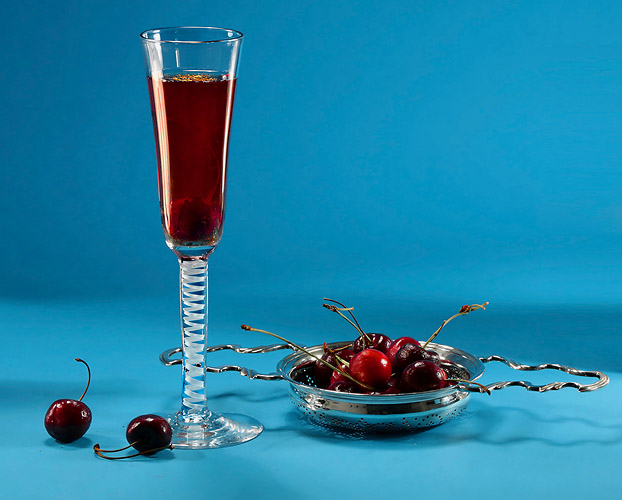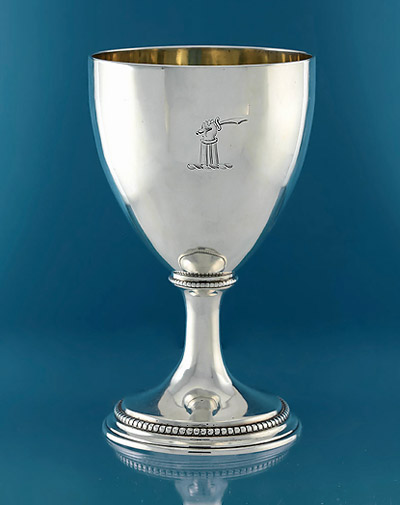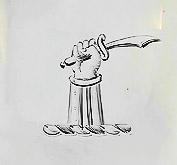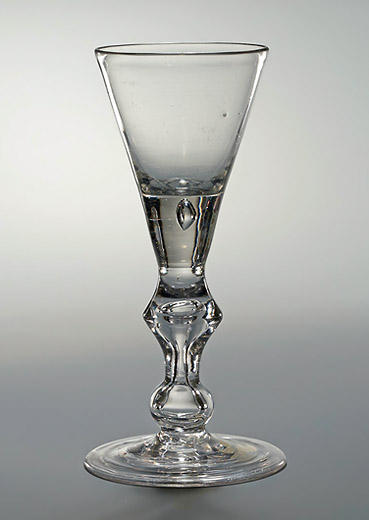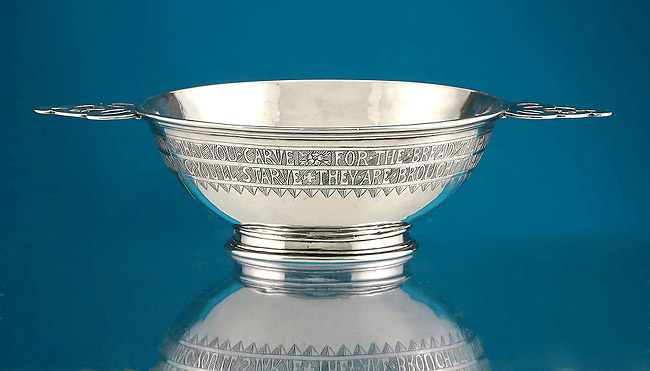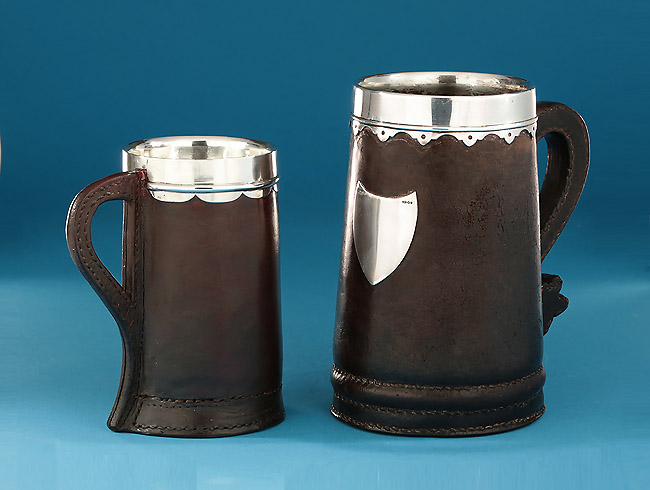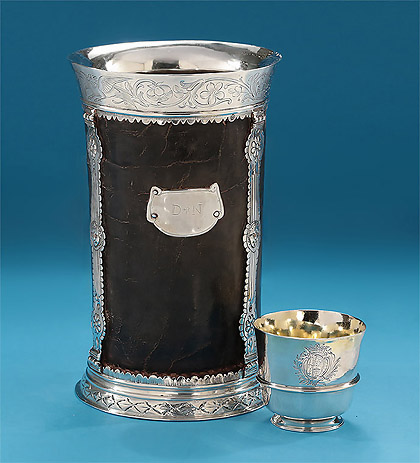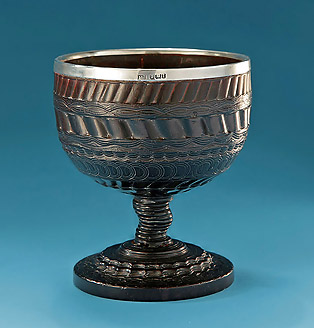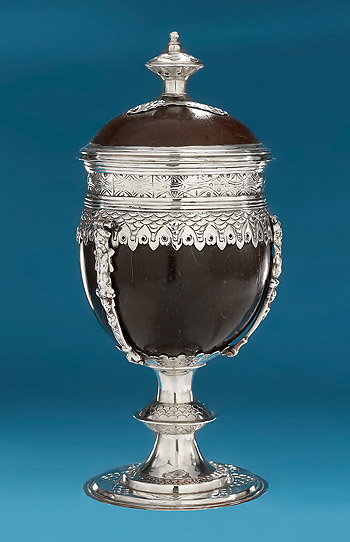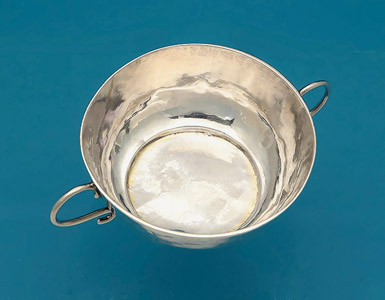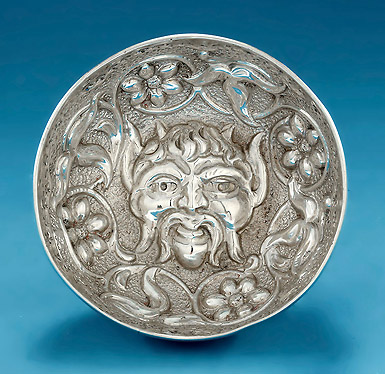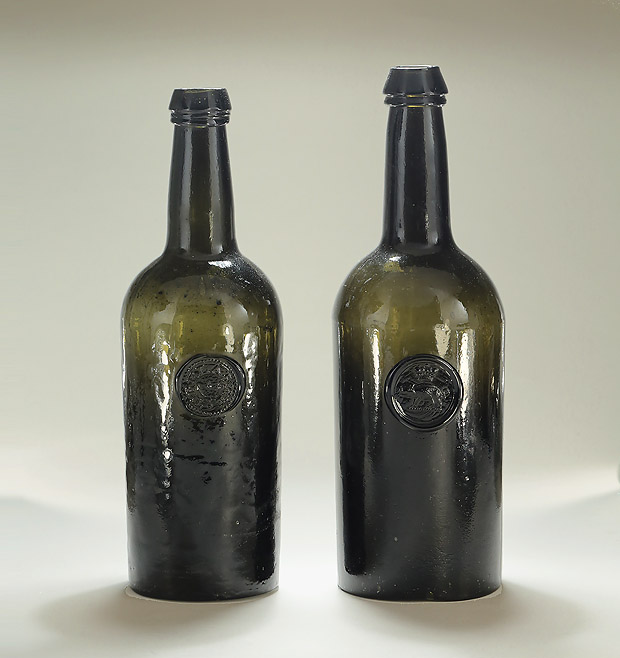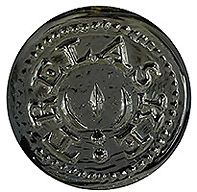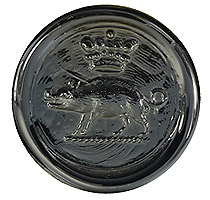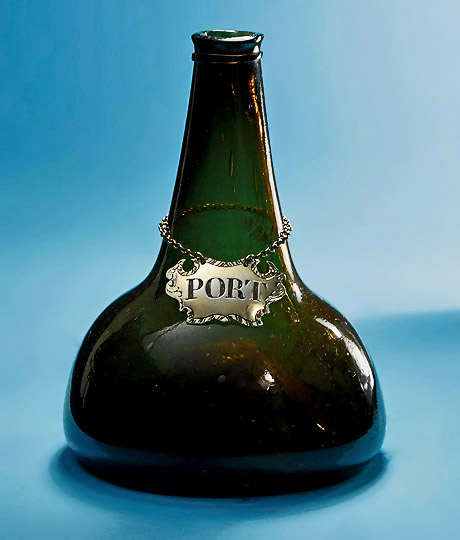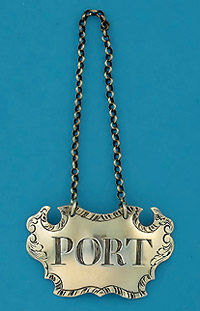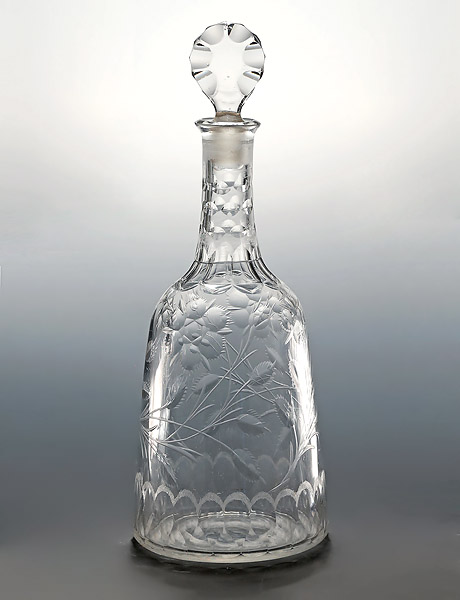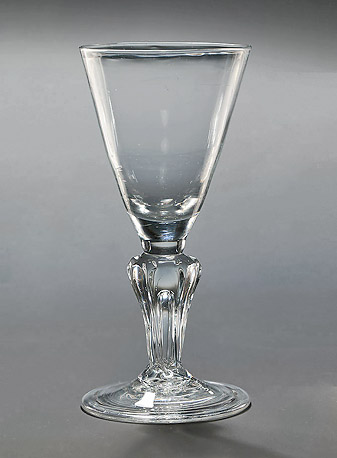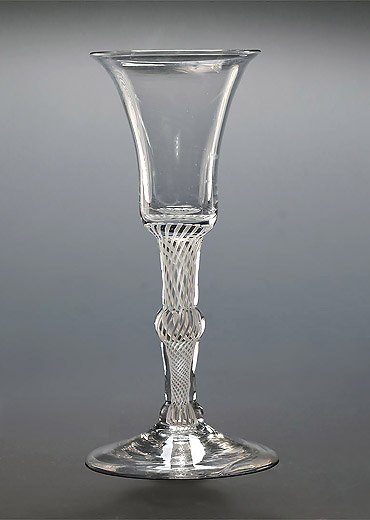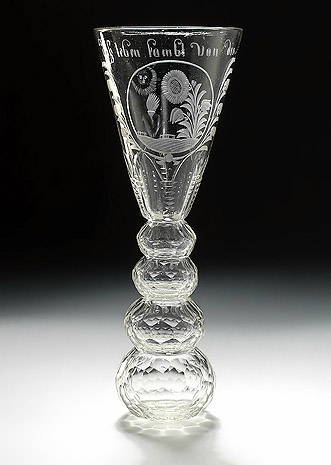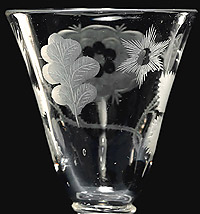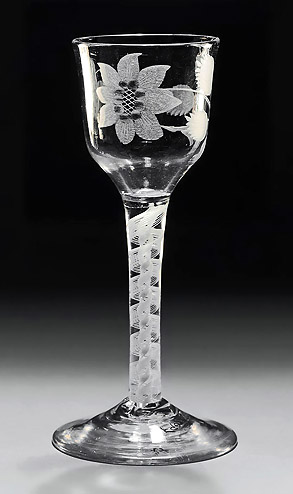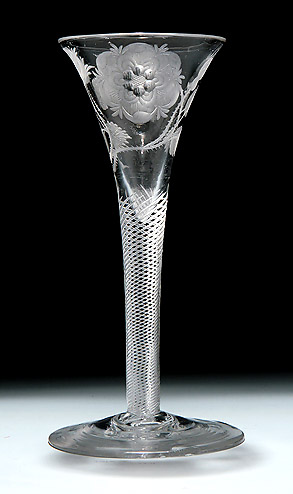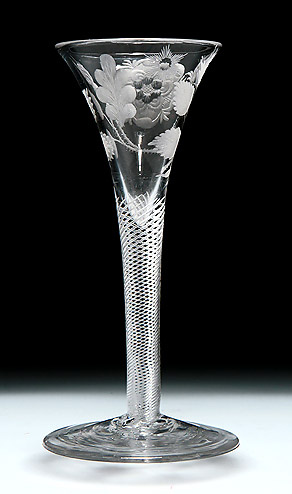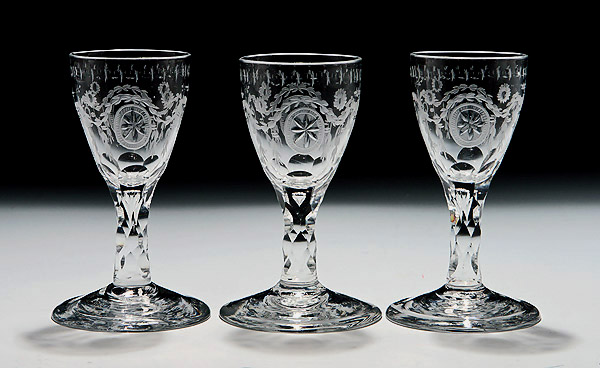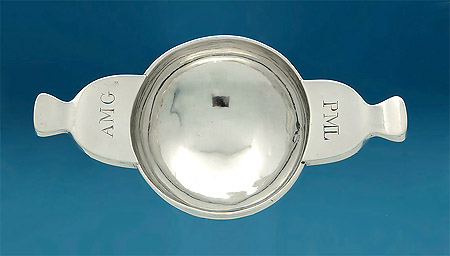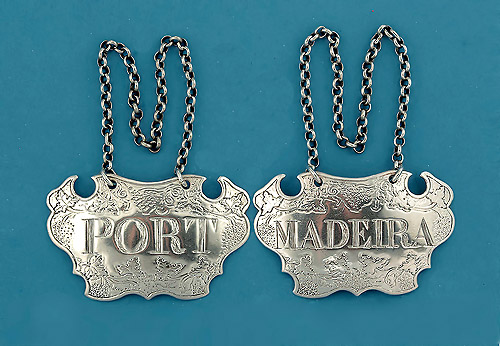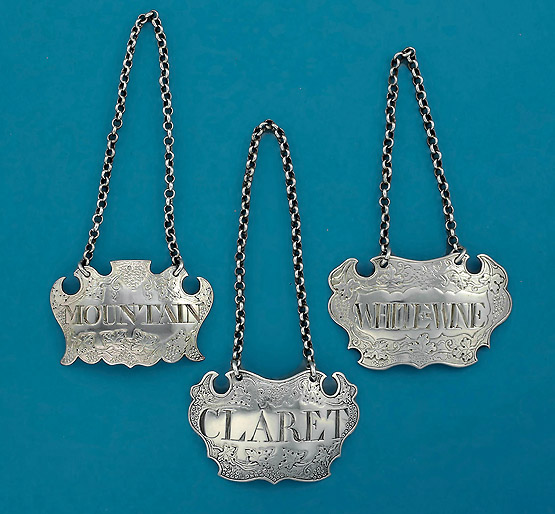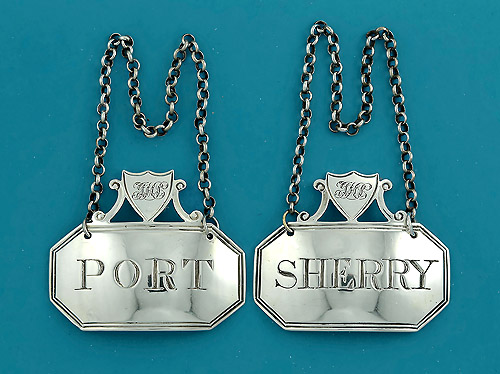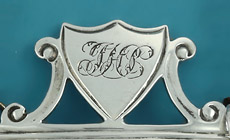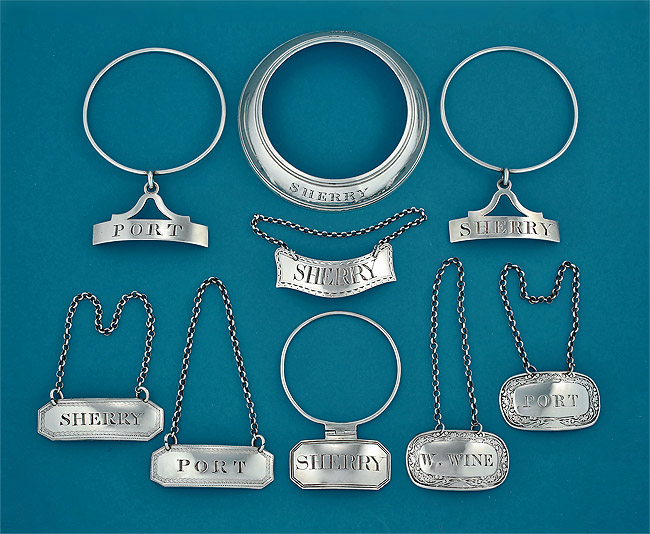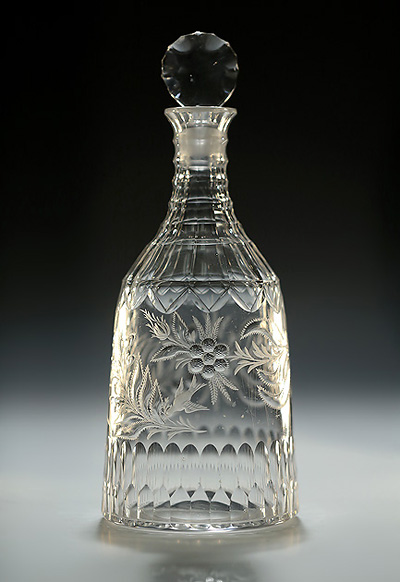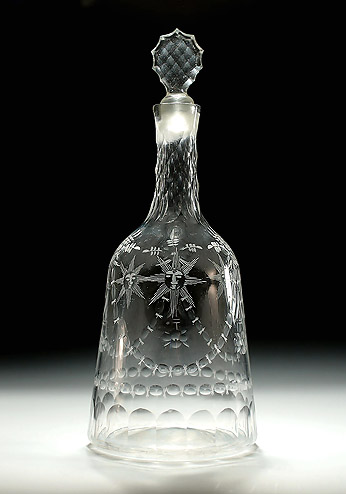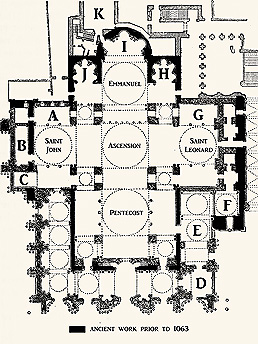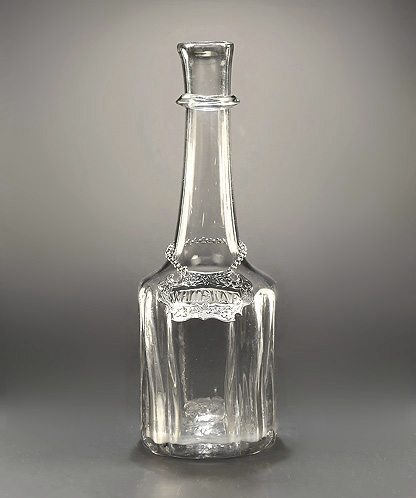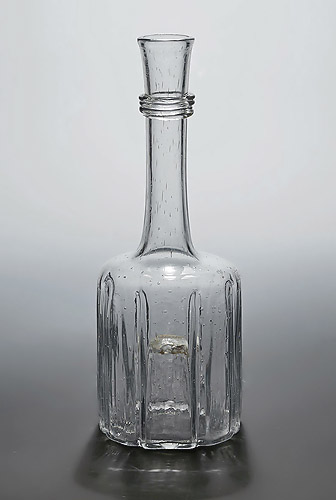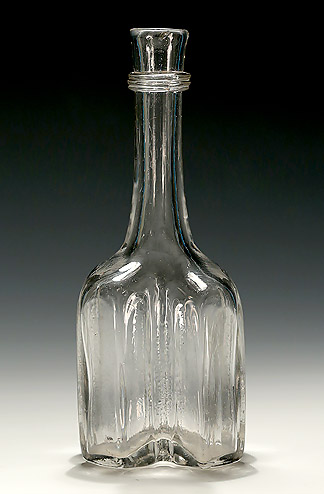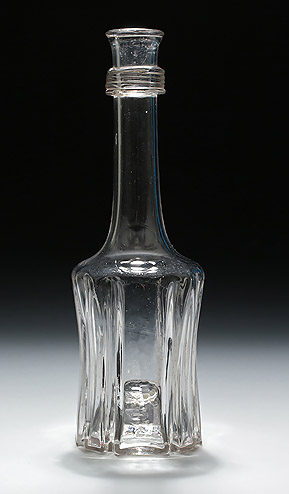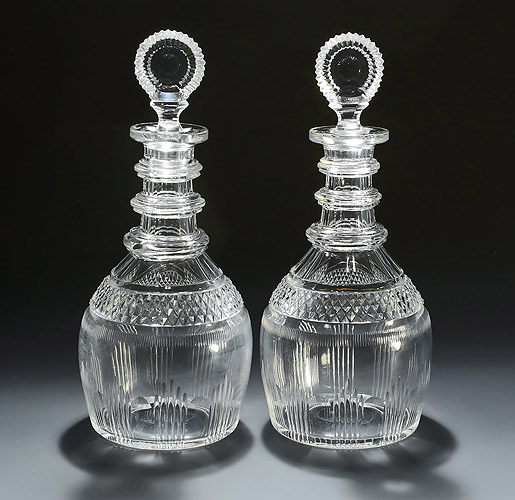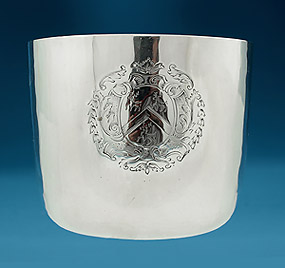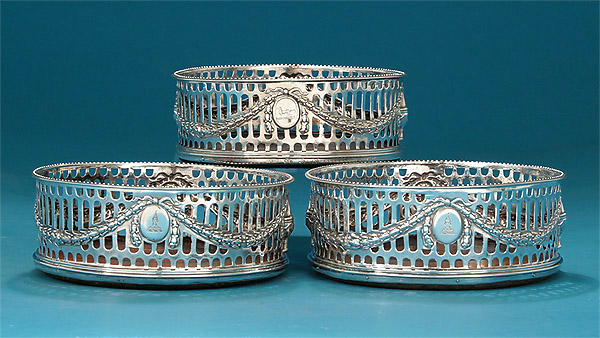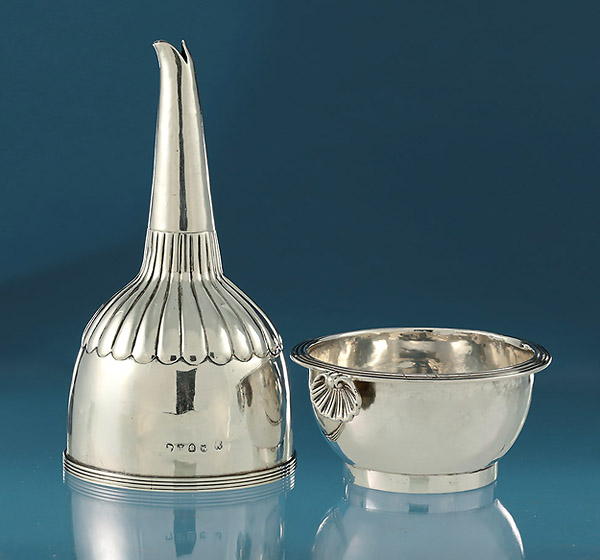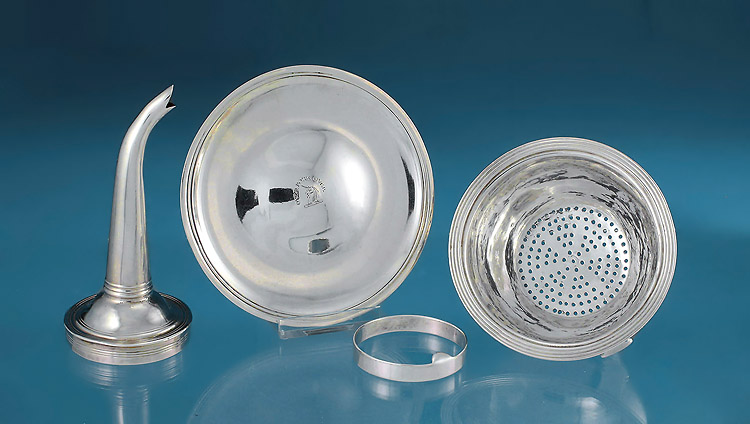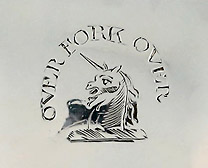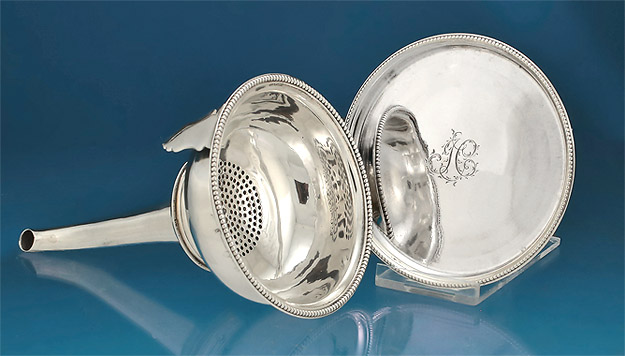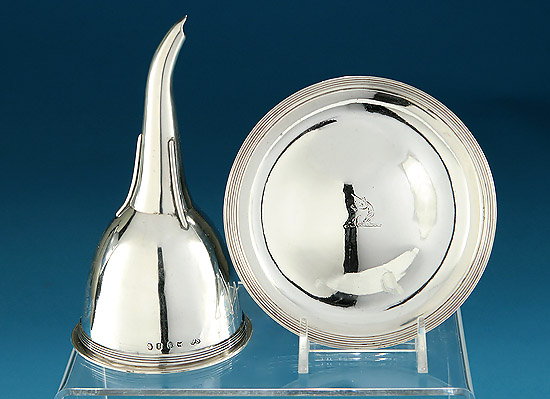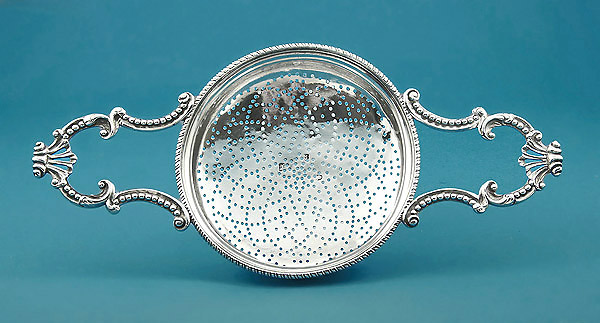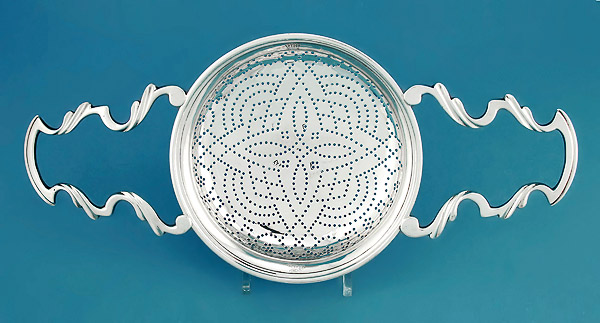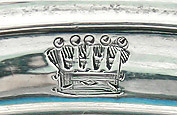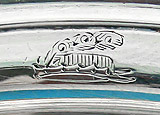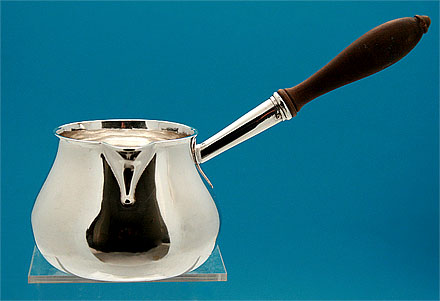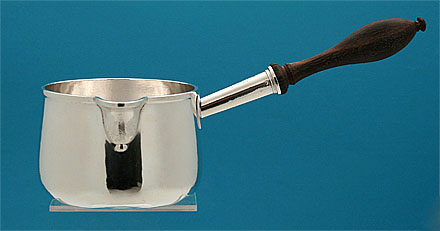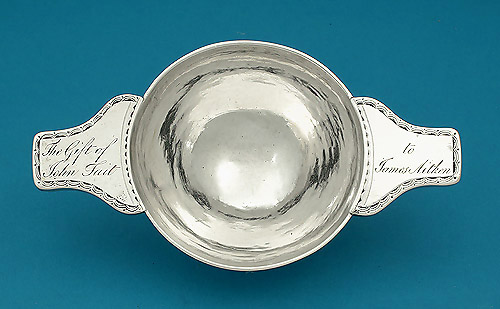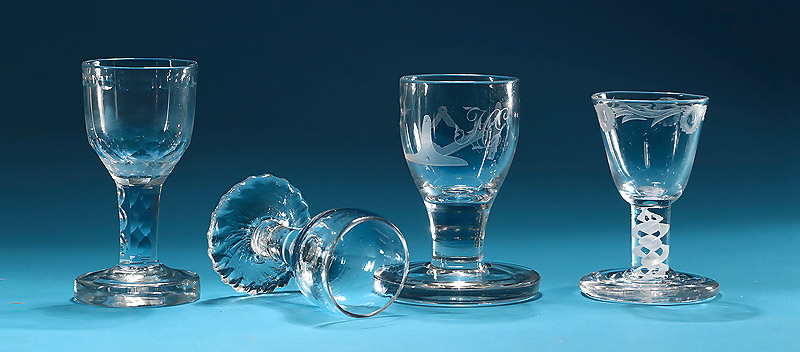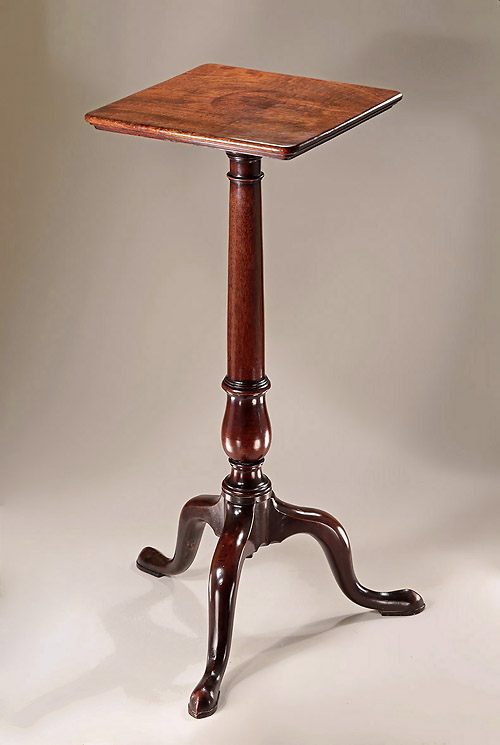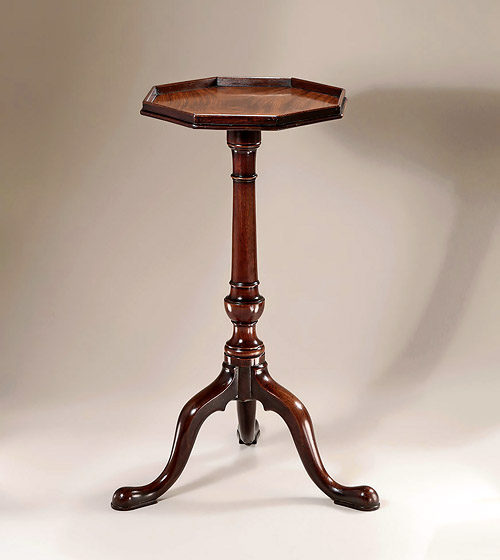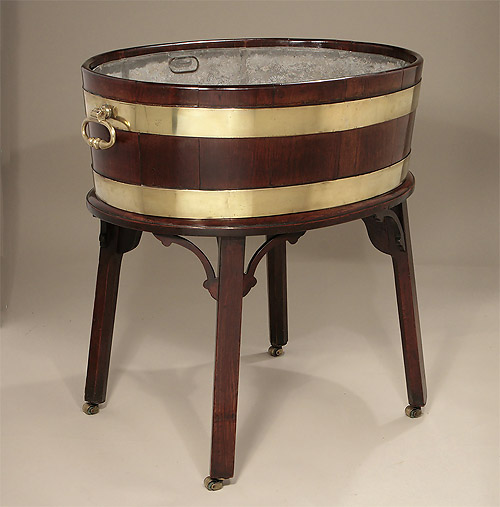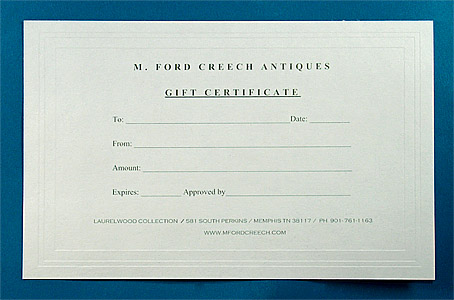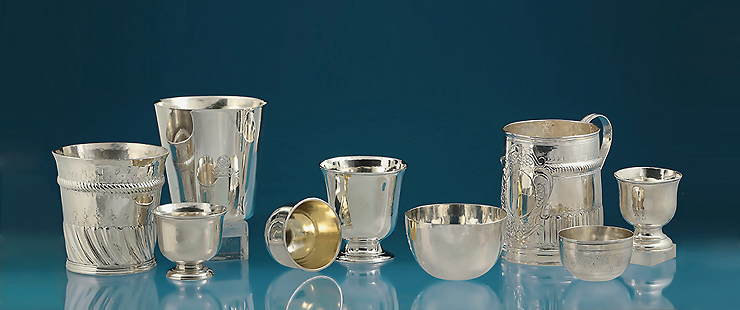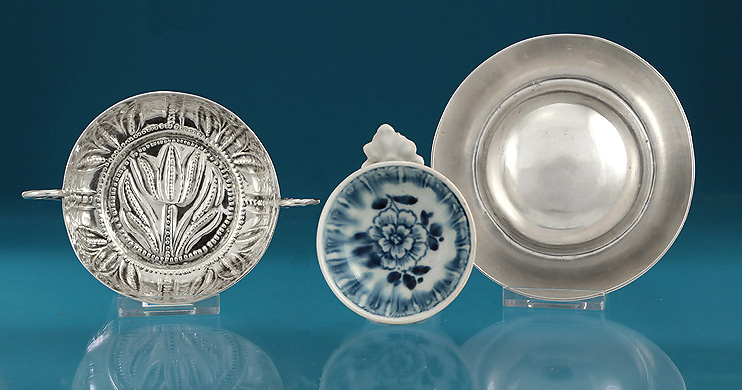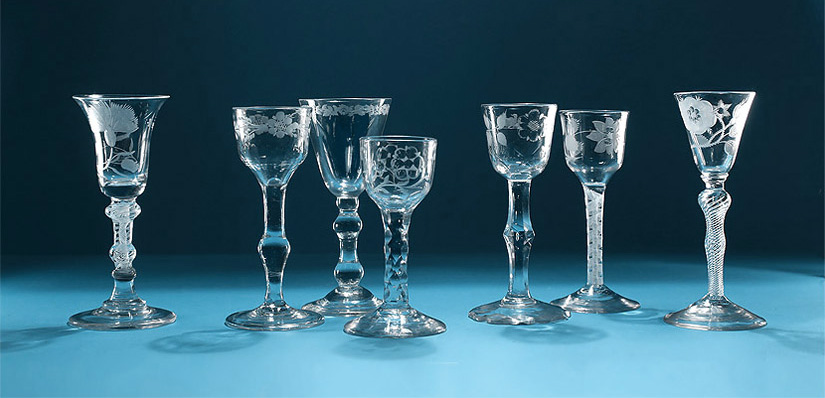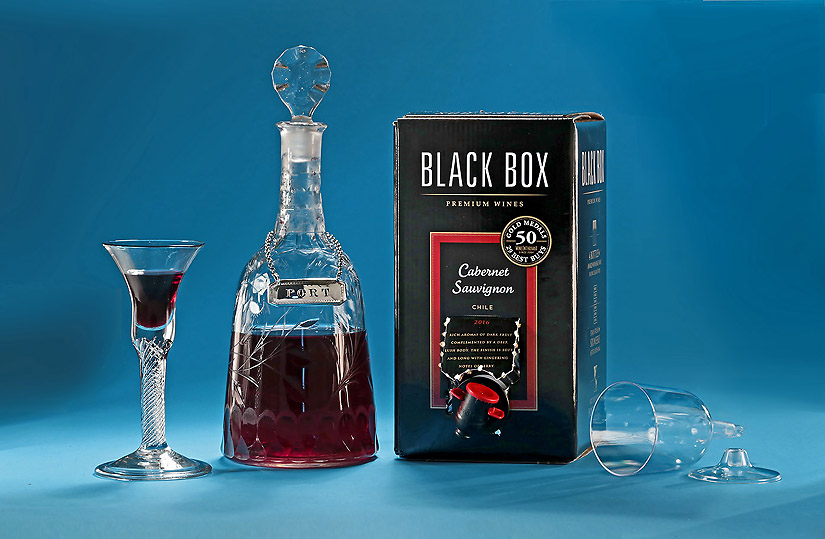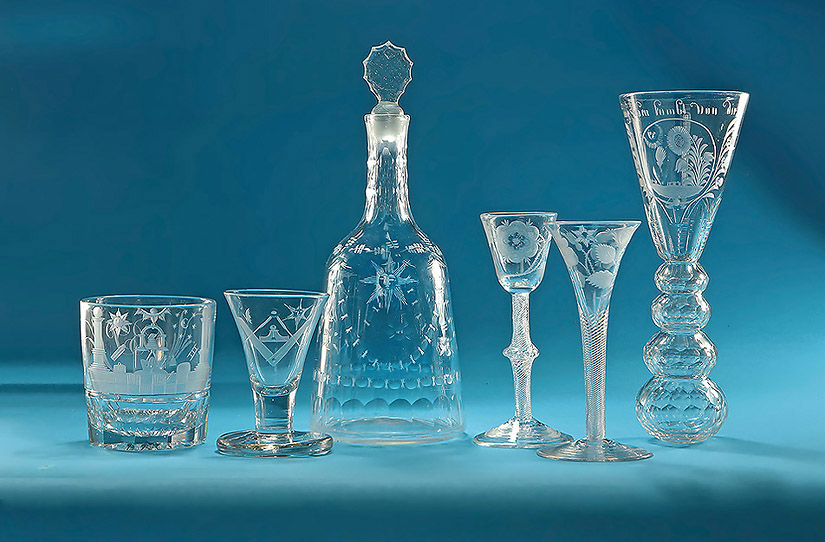|
'SPIRITS & WINES'
(Home Page: www.mfordcreech.com)
To receive our periodic email catalogs, please click here /
GALLERY HOURS : 12-6 FRIDAY & SATURDAY MONDAY - THURSDAY, BY CHANCE or BY APPOINTMENT WE ARE ALWAYS OPEN ONLINE & BY EMAIL Contact : mfcreech@bellsouth.net / 901-827-4668
|
|||||||||||
For guiding us through "the twists and turns of life"... For "bolstering our courage" in those times of strife ...
| |||||||||||
|
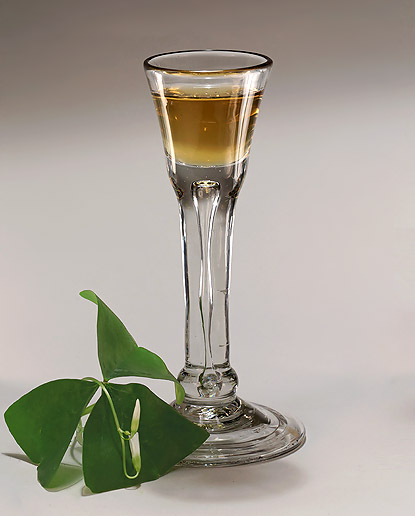
Rare George II Irish Cordial Glass
Although glassmaking in Ireland dates to the late 16th century, SOLD
|
|||||||||||
Charles II Silver Wine Taster The shallow circular bowl chased with tulip floral and leaf decoration, SOLD
|
|||||||||||
Rare George II Silver Saucer-Form Domed Wine Taster SOLD
|
|||||||||||
Good Pair of Matthew Boulton Old Sheffield Plate Wine Coolers 8.75" High
|
|||||||||||
George III Provincial Silver 'Quart' Mug, John Langlands I, Newcastle, 1770 Of heavy gauge silver and tapering cylindrical form, 6.75" High / 19.8 oz. SOLD
|
|||||||||||
Silver-Mounted & Crested Leather Black-Jack SOLD
|
|||||||||||
Early George III Silver Fluted Quart Tankard William Grundy, London, 1761 Of heavy gauge silver, the marks struck above the rim decoration 6.25" High / 4" Wide at Rim / 5" Wide at Base / 20.6 oz.
SOLD
|
|||||||||||
William III / Queen Anne Heavy Baluster Goblet, England, c1700-1710 England, c1700-1710, 7.5" High An almost identical goblet is illustrated, "Investing in Georgian Glass", (Ward Lloyd, p.38) : "A good early baluster goblet dating from about 1700. The round funnel bowl has a slight extrusion in the base, the stem is an inverted baluster and the foot is domed and folded." SOLD George I / II Baluster Cordial or Gin Glass England, c1720-30, 5.5" High With good grey color, the bell bowl with solid base above a solid stem headed by a 3-ringed annular knop over a central ball knop and flattened basal knop, raised on a round and folded foot; these small glasses are "uncommon" SOLD George I Two-Teared Baluster Wine Glass, c1720 England, c1720, 6.5" High with teared inverted baluster stem, considered the 'most comfortable' to hold in the hand. Provenance : 'The Harding Collection', Sotheby's London
|
|||||||||||
George II 'Kit-Cat' Type Wineglass Glasses of this form - with plain stem and central or lower baluster are often referred to as 'Kit-Cat' glasses, referring to glasses depicted in Sir Godfrey Kneller's c1721 painting of two members of the 'Kit-Cat Club', London dining society which began meeting in the 1690s. 6 5/8" High / 3 1/8" Diameter, The Foot / 3" Diameter, The Rim / 5.2 oz SOLD
Sir Godfrey Kneller, c1721, portrait of Kit Cat members (National Gallery, London), "Thomas Pelham-Holles, 1st Duke of Newcastle-under-Lyne; Henry Clinton, 7th Earl of Lincoln"
|
|||||||||||
George II Engraved Pan-Topped 'Mercury Twist' Wine Glass The pan-topped bowl having an engraved floral border to the rim,
|
|||||||||||
George II Jacobite Pan-Topped Airtwist Wine England, c1750 The pan top bowl engraved to the upper border engraved with SOLD
|
|||||||||||
George II Airtwist Cordial Glass A quite heavy glass, having a round funnel bowl with fluted lower half,
|
|||||||||||
Two Jacobite Interest Cordials, England, c1765 The left, engraved example with "a daffodil, and crested bird in flight", over a double series opaque twist stem. ("Daffodils" symbolize "hope"- the return of spring, and akin to the sunflower, the return of the Stuart reign). The right, engraved with a "sunflower and forget-me-not sprays, a crested bird in flight" on the reverse, over double series opaque twist stem. In the Center : A George II / III Jacobite Airtwist Wine, c1755-60 A heavy glass raised on a rather rare domed foot, and engraved with a "6-petaled Jacobite rose sided by two buds on thorny stems". EACH SOLD
|
|||||||||||
George III Face-Cut Engraved Wine Glass, 6-Petal Cut Foot England, c1770-80 The bowl engraved with grape leaves
and polished concave clusters of grapes
Note : Probable Jacobite association : These glasses blown and cut with Stuart six petal rose-shaped feet were ,
|
|||||||||||
Louis XV Provincial Silver Wine Taster SOLD
|
|||||||||||
Charles II Provincial Silver Wine Taster England,c1670 Maker's Mark Only (Indistinct), possibly West Country,
Although there are several records of wine tasters in English 14th and 15th century manuscripts, the earliest British silver wine tasters are from the 17th century, with very few being made after 1750. Most from the 18th and 19th centuries come from France. There were two forms : this form with the shallow bowl and 2 wire loop handles, and a later form with domed center. Interestingly, wine tasters are an outgrowth of small tasters made during the medieval period to taste contents of bowls, to convince guests that the food was not poisoned.
3.5" Diameter / 2 oz. SOLD
|
|||||||||||
Early George II Baluster Wine Glass SOLD
|
|||||||||||
Rare George II Jacobite Water Glass England, c1750 Engraved with a rose and bud on stem amongst floralsprays, a winged bird verso,
"Jacobite clubs developed different ways of drinking the toast, and passed the wine glass, held in the right hand, over the water before drinking the toast." This practice still exists today on the anniversary of the Battle of Culloden : "After dinner, glasses of water are set around the table and wine glasses are filled. The toast to "The King over the Water" is given,
SOLD
|
|||||||||||
Rare Pair of c1750-60 Jacobite Water Bowls The bodies encircled by finely engraved garlands, including a 6-petaled Jacobite rose, a carnation, honeysuckle, apples, fruiting vines, other flowers, and a sunflower,. 4.75" Wide
A pair of wine glasses (Drambuie Collection) having very similar borders is illustrated in 'The Jacobites & Their Glasses', Seddon, pl. 33 with the following notation : "With a little imagination the initial letters of the flowers can sometimes be made to spell 'Charles'". Small glass water bowls as these were often used in toasting "the King across the water". SOLD
|
|||||||||||
Rare Pair of George II Glass Water Bowls Jacobite Interest, c1745-50 Each thick heavy deep round bowl of inverted ogee shape, Carnation, Tulip issuing a further tulip, Lily of the Valley, & Scottish Roses Each 4.25" Diameter / 30.5 oz. SOLD
|
|||||||||||
George III Silver Lidded & Bright Cut Tankard Langlands & Robertson, Newcastle, England, 1782 Of heavy gauge silver, the cover with central unengraved shield SOLD
|
|||||||||||
Late George III Engraved Lady's Glass Half-Pint Tankard England, c1800-1820 Of good weight and condition, with lovely handle; Engraved to the front with scrolling fern-like fronds and the inscription : 'Ethel Randle from A.D' : 4.25" High / 4.5" Across Handle / 12.7 oz.
|
|||||||||||
|
|
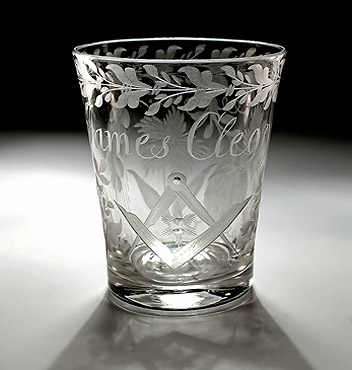 |
||||||||||
Two Quite Fine George III Masonic Tumblers
Left : Fine Cut & Engraved Masonic Tumbler England, c1810, 3.75" High Of heavy weight lead glass, the reverse with conjoined script initials BP within a pair of Barley shafts;
Right : Beautifully Engraved Masonic Tumbler England, c1790, 4.25" High The slightly flaring glass with the Masonic compass and square
|
|||||||||||
Charles II Silver Miniature ( "Toy") Porringer London, 1761, M N, a crescent below, within a heart 2" High x 4.5" Wide / 2.2 oz.
These small baluster-form cups were popular from c1640 to 1700, are technically called "caudle "cups". Recently, the term "porringer", a straight-sided cup, has become the prevalent term for both forms. The miniature, or "toy", version (2" -3" in height), popular in the mid-17th century, had no lid, and usually simple chased or pounced decoration, with clipped silver wire handles. They were used for a warm drink composed of ale, sugar, eggs, bread and spices, and often given as gifts to the mother of a newborn child.
Today these small cups are also often used as wine tasters, as the chasing offers wells and bubbles for discerning color and clarity.
SOLD
|
|||||||||||
One of the earliest records of tumbler cups is that of Samuel Pepys, on October 24, 1664. The earliest silver known tumbler cups still in existence date to 1671, at All Souls Oxford.
Three Early Silver Tumbler Cups, c1690-1731 (Left to Right) : George I Silver 'Tumbler Cup', James Goodwin, London, 1723 Early George II Silver 'Tumbler Cup', William Allen I (likely), London, 1731 (SOLD) James II / William & Mary Small Silver 'Tumbler Cup', Roger Strickland, London, c1690 (SOLD)
|
|||||||||||
Fine George III Silver Tumbler Cup SOLD
|
|||||||||||
"Tot cups" are small drinking vessels, sometimes with a single handle, or handleless, in beaker form. They are usually footed and dram size (about two inches). Tot cups are said to be predecessors of the later Georgian “stirrup cups” - so popular in both silver and ceramic from the mid-18th century forward. Tot cups, like stirrup cups, were likely handed to riders before or after a hunt, and meant to be drunk without putting the vessel down. Early silver tot cups of any form are scarce, if not rare.
Three Early Georgian Silver Tot Cups (Left to Right) : Scarce Early George II Silver "Tot Cup", Thomas Parr II, London, 1730 Scarce Early George II Silver 'Tot Cup', William Paradise, London, 1732 Scarce George I Silver 'Tot Cup', 1724, Scratch-Initialled 'AP 1723' (SOLD)
|
|||||||||||
Aaron Lestourgen, London 1774 Crested for the Family of Kirkby : Willliam Comber Kirkby (Lancashire and Hampshire), gilt interior / 3.25" High x 3" Wide / 4.7 oz. SOLD
Charles Wright, London 1775. Arms for the Browne Family (Given the dates of the hatchments in respect of Anna Maria Browne and Charlotte Browne, there is a possibility that this beaker was once in the possession of either Anna Maria or Charlotte as spinsters prior to their respective marriages.) 3" High / 2.8 oz. SOLD
Beakers date to the earliest times in pottery. There was even a western European Neolithic culture named "Beaker Folk". The cylindrical vessels arrived in Britain about 2500 BC. Some excavated early pottery beakers contained "meadowsweet pollen" - still used today to flavor beer and the drink "mead". Although small silver beakers were commonly used in England from c1560-1685, late 17th century glass production overshadowed the British silver beaker, reducing its occurrence thereafter.
|
|||||||||||
Queen Anne Britannia Silver Beaker William Gibson, London, 1702 Good marks to the upper rim 3” High / 3.8 oz. “Beakers are usually made in three parts, the sides being made from sheet which is hammered into the round and then seamed vertically, the base and foot wire applied separately. The form of the beaker varies very little from the 17th to the 19th centuries…. Beakers are comparatively rare from this (Queen Anne) period.” (Antique Silver, Peter Waldron, p163, 164)
|
|||||||||||
Thomas Edwards, London, 1839 The bowl finely engraved with ovals of winged moths and scrolling foliage, raised on a cast and stippled silver mount and foot; fully marked; Fine quality and craftsmanship 5" High / 4.7 Total oz. SOLD
|
|||||||||||
Rare George III Silver-Mounted Carved Lignum Vitae Tankard Henry Nutting, London, 1805 above a band of horizontal rectangles representing basket-weaving, SOLD
|
|||||||||||
George III Enamel Twist Ratafia Glass England, c1760
Ratafia is a rather ancient alcoholic drink, characterized by the infusion of soft fruits Ratafia has a pungently sweet aroma and is at times served with flakes of gold atop.
True Ratafia glasses are somewhat rare, having narrow upright bowls,
8.25" High
|
|||||||||||
|
John Swift, London, 1799 The ovoid body crested for Jolliffe (Somerset) and inscribed verso H over I * M and 1780; gilt interior and beaded collar and footrim 6" High / 7 oz.
SOLD
|
|||||||||||
Queen Anne Heavy Baluster Drinking Glass Collector's #3 on footrim SOLD
|
|||||||||||
Early George V Engraved Silver Quaich The Bowl, 5.75" Wide, 9" Across the Handles / 11.4 oz. SOLD
|
|||||||||||
Georgian Silver-Mounted Leather Tankard (Blackjack), England, 18th Century (Left) The body with 5 impressed "stars" to the center front SOLD Georgian Silver-Mounted Leather Tankard (Blackjack), With Later Unengraved Shield (Right) England, 18th Century, The Mounts with 1905 Birmingham Import Marks SOLD
|
|||||||||||
Scarce Silver-Mounted Leather Black-Jack (Pictured with a William & Mary Silver Tot Cup, Ralph Leake, London, 1695) SOLD
|
|||||||||||
Fine 17th Century Silver-Mounted Lignum Vitae Carved Goblet England, c1680 Complex engine turning throughout, and with spiral stem The silver rim mounted, Sheffield, 1911, EWO & Co. 4.25" Wide High x 3-78" Wide SOLD
|
|||||||||||
18th Century Silver-Mounted Coconut Cup and Cover Unmarked to the Body, Cover Maker's Mark Rubbed, Probably Continental The silver-lined ovoid bowl having silver mounts with fish-scale diapering & pierced border, supported by three silver Atlanteans over a knopped pedestal stem and stepped base, also with scale diapering, the coconut cover with knopped silver finial and escutcheon 10" High SOLD
|
|||||||||||
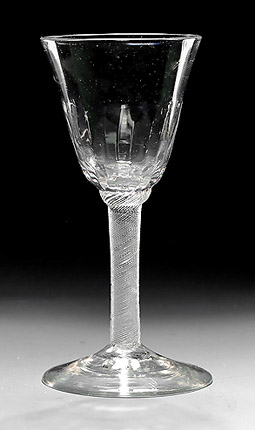 |
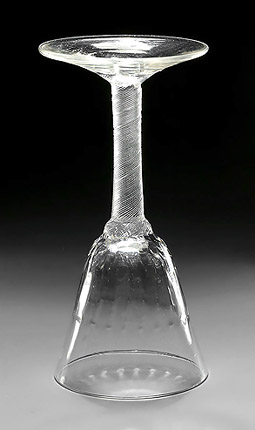 |
||||||||||
George II / III Incised Twist Stem Wine England, c1755-65 The round funnel bowl vertically moulded flutes ending in small knops, over a finely insiced stem and conical foot and snapped pontil ; very nice quality 5.25" High
|
|||||||||||
|
|||||||||||
|
Rare William III Silver Wine Taster London, 1697-1700Marks rubbed, ?E, Britannia and lions head erased visible 3" Bowl Width / 4'' Over Handles / 1.6 oz
Very few wine tasters were
made in England as wine was not a “national product”. However for a short
period in the second half of the 17th century, a
number of wine tasters were produced in England. There is an interesting note in Great British Wine Accessories (Butler), p. 69, fig.
4/6, regarding this type of small silver
wine taster, possibly being used - not as a merchant's
taster - but one in which a servant would
taste wine, demonstrating to the host and guests that is was
not poisoned. A similar twin handled cup is
shown, c1670, by an unidentified English maker. SOLD |
|||||||||||
Victorian Silver Bacchanalian Wine Taster Rosenthall, Jacob & Co., London, 1884 The delightful Victorian silver wine taster of deep circular form, elaborately embossed, centering a smiling Bacchus mask surrounded by a matted ground and scrolling foliage encircling flowerheads 2.75" Diameter / 6 oz. SOLD
|
|||||||||||
Two Dark Green Glass Sealed Cylinder Wine Bottles With Seals for The Trelaske Family, Lewannick, Cornwall (above & below left), c1800, 10.75" Higm and The Edgcumbe Family, Cornwall (above & below right), c1820, 11.5" High
SOLD
|
|||||||||||
Good English Black Onion Bottle, c1710-20 The heavy deep black-green bottle having good density and shiny surface, the verso with a high kick-up and snapped pontil, the neck with an applied ring; without damages and chips; very suitable for table use 7.5" High x 6" Diameter at Base SOLD
Shown with an Early George III Silver-Gilt Escutcheon Bottle Ticket PORT, Richard Binley, London, c1760
SOLD
|
|||||||||||
|
|||||||||||
George III Engraved Sugar Loaf Decanter Jacobite Interest, England, c1770 Engraved with two sprays, each issuing a single stem having small leaves and three cut and polished flowerheads : 11.5" High SOLD
|
|||||||||||
George II 6-Sided Moulded Pedestal (Silesian) Stem Wine England, 1740 The conical bowl over a 6-sided pedestal stem with diamond-topped shoulders and central large elongated tear; folded foot & snapped pontil; the verso with collector's inventory number 5.75" High
|
|||||||||||
George II / III Multi-Spiral Opaque Twist Stem Wine Engand, c1760 Of good weight, the bell bowl having a solid base 6-5/8" High / The Rim, 2-3/5" / The Foot, 3" SOLD
|
|||||||||||
|
|||||||||||
Rare Continental Cut & Engraved Ceremonial Glass Mid to Late 18th Century, Probably Bohemian
The large glass with a cut and engraved drawn funnel bowl over a stem of 4 graduating hollow facet cut knops,
The precise original use of this glass (or cup) is not yet known. 9.5" High SOLD
|
|||||||||||
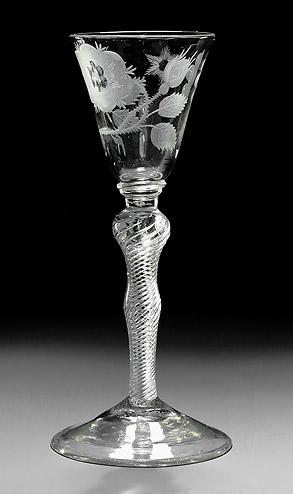 |
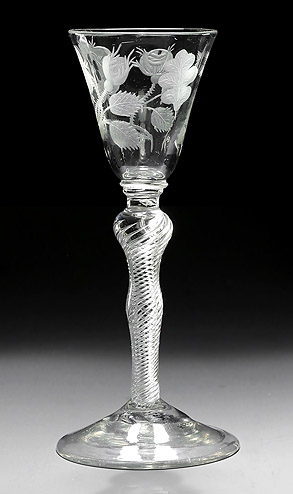 |
||||||||||
George II Jacobite Engraved Airtwist Wine With Stuart Rose, Oak Leaf and Star England, c1750 (The engraver likely Engraver C, as discussed and pictured in 6.25" High
SOLD
|
|||||||||||
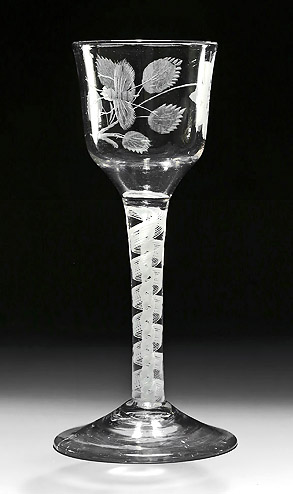 |
|||||||||||
George III Jacobite Moulded Bowl Opaque Twist Wine Daffodil & Bee, England, c1750 Daffodils symbolized 'hope'- the return of spring, SOLD
|
|||||||||||
|
|
|||||||||||
George II Jacobite Trumpet Form Wine England, c1745 With Stuart Rose and two buds, the sun and a white oak leaf
Ref : An identical glass is illustrated The Book of Wine Antiques, Butler & Walkling, p. 200, Pl. 205, the frontal rose and sun to the backside both being visible.
Bonnie Prince Charlie and the Royal House of Stuart 1688-1788 : Works of Art from the Drambuie Collection, Robin Nicholson, p. 16, cat. no 15 A "Chastleton Manor" decanter and four wine glasses c. 1750, Pl. ii, an identical wine glass with drawn bowl and air twist stem height 6-1/4 inches engraved with rose, two buds, “star” and oak leaf :
Provenance : Christie's London 6" High SOLD
|
|||||||||||
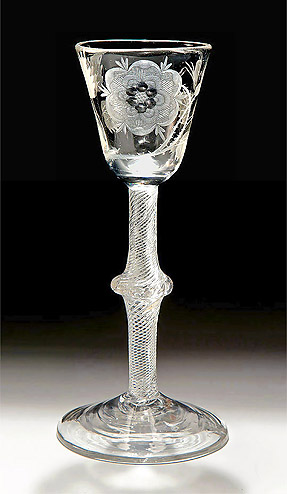 |
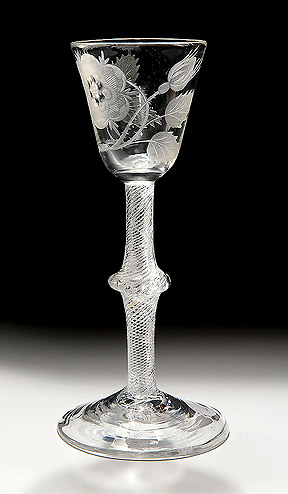 |
||||||||||
George III Jacobite Airtwist Wine England, c1750-60 engraved with a Stuart 6-petaled rose and a single bud and leaves, 6.25" High SOLD
|
|||||||||||
|
|||||||||||
Set of Three George III Engraved Facet Cut Wines England, c1780 Extremely well engraved 4-3/8” High
|
|||||||||||
George III Scottish Provincial Engraved Silver Quaich Charles Jamieson, Inverness, c1810 Having twin shaped lugs with upper surfaces engraved AMG and PML (untraced), 5-5/8" Wide, Over Handles / 2-7/8" Diameter, The Bowl / 3.2 oz. Ref : Lyon & Turnbull, Edinburgh, 13 August 2014 "Inverness - a scarce Scottish provincial quaich,
Charles Jamieson", SOLD
|
|||||||||||
Pair George II Silver Escutcheon Bottle Tickets Sandilands Drinkwater, England,c1745-50 The centers incised for PORT and MADEIRA, 2.25" Wide / .8 oz. SOLD
|
|||||||||||
Three George II Silver Escutcheon Bottle Tickets, c1739-50 'MOUNTAIN' James Slater, London, 1739-50 (SOLD) 'CLARET' Thomas Rush, London c1740 'WHITE.WINE' William Cripps, London, 1743-50 Each Priced Separately
("Mountain" is a fortified dessert wine, sweet and dark, from the Malaga area of Spain. It was very popular during the whole of the 18th century, but rarely found later.) "Wine Labels", E.W. Whitworth, p.55
|
|||||||||||
Good Pair of George III Silver Bottle Tickets
|
|||||||||||
Rare George III Provincial Silver Bottle Ticket - 'MADEIRA' John Langlands I and John Robertson, Newcastle, c1790
|
|||||||||||
18th & Early 19th Century British Silver "Neck-Ring" Bottle Tickets, & "Collar" and Good Irish Silver Bottle Ticket, "Sherry", Benjamin Tait, Dublin, c1790 (SOLD)
Bottom Left : Good Pair George III Irish Silver Bottle Tickets, John Stoyte, Dublin, c1788, "Sherry" & "Port"
Bottom Right : Good Pair George III Silver Bottle Tickets, "W. Wine" & "Port" John Brockwell, London,1811
Click images or text for linked pages
|
|||||||||||
Georgian Silver Rectangular Bottle Tickets, Various, 18th Century
|
|||||||||||
Fine George III Cut & Engraved Glass Decanter England, c1770 Of heavy weight, well cut and engraved,
|
|||||||||||
|
|||||||||||
George III Cut & Engraved Sugar-Loaf Decanter, Masonic Interest England, c1780
The high shoulders in "sugar-loaf" (or mallet) form, resembling the "Masonic maul", suspended from floral and foliate sprays with corresponding dependent drops, 11" High Illustrated in Andy McConnell's new edition of 'The Decanter". SOLD
|
|||||||||||
'CRUCIFORM' CARAFE FORM DECANTERS
Late 17th and early 18th century decanters were made from heavy mould-blown glass with high kicks I the base – the kicks offering larger surfaces for cooling as well as protection from the often rough pontil. They were used for serving and stoppers, when used, were loose corks or plugs, secured with string. Between 1720 and 1730, a group of carafes known as 0 "cruciform decanters" were introduced. They led quickly to the mid-18th century clear glass decanters with fitted stoppers.
(A reference to the shape : Byzantine 'Cruciform; Floor Plan, St. Mark's Basilica, Venice, Italy)
England, c1740 The thick moulded body with having subtle cruciform shape and rounded shoulders, 9.25" High Shown With Rare George II Silver Escutcheon Bottle Ticket, WHITE.WINE William Cripps, London, 1743-50
|
|||||||||||
|
England, c1740 Eight sided with three applied neck rings; wonderful interior bubbling to the thick early glass Provenance : Bernard Watney 9.25" High SOLD
|
|||||||||||
|
|||||||||||
Good Pair of George III Three-Ring Cut Glass Decanters SOLD
|
|||||||||||
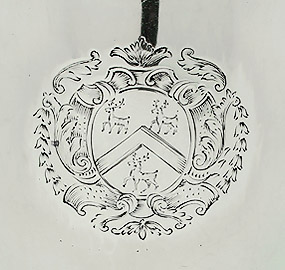 |
|||||||||||
William & Mary Silver Tumbler Cup IC in a shaped punch, a mullet below (Jackson's Revised, p.137, as found on 2 tankards, 1685-6, and a toy porringer 1691-2) Bearing arms for the family of Rogers (Rodgers, Roger) 2-7/8" High, 3-3/8" Wide / 4.8 oz SOLD
|
|||||||||||
Set of 3 George III Silver Wine Coasters John Rowbotham, 1775, Sheffield An early set, crested for Everard and an Unknown Family
|
|||||||||||
Very Good George III Silver 2-Part Wine Funnel having floriform piercing to the strainer and a shell tang SOLD
|
|||||||||||
George III Silver Three-Part Wine Funnel With Associated George III Scottish Silver Reeded Funnel Stand Alexander Gairdner, Edinburgh, c1790 Crested for Cunninghm :
SOLD
|
|||||||||||
A Scarce Early George III Irish Silver Wine Funnel Stand (Drip Pan) The Stand William Bond, Dublin, 1761 The Funnel, London, 1783, Marks Rubbed (an early example); SOLD
|
|||||||||||
George III Silver Wine Funnel, Stephen Adams II, London, 1804 - SOLD Shown With George III Irish Provincial Silver Wine Funnel Stand, Joseph Kinselagh, Cork, c1790 - SOLD The domed stand crested for Thomas Carr, Freemason and author of “The Ritual of the Operative Free Masons”
|
|||||||||||
George III Silver Lemon (Punch) Strainer Charles Aldridge & Henry Green, London 1771 Literature : Recently published in "Silver Lemon Strainers, 1686-1846", Michael Adams, Fig. 62, p. 72 : 8-7/8" Wide / 4 oz.
|
|||||||||||
George III Silver Lemon (Punch) Strainer Samuel Meriton II, London, 1780 crested for Molyneux, Earls of Sefton Literature : Recently published in "Silver Lemon Strainers, 1686-1846", Michael Adams, Fig. 108, p. 89 : 4.25” Diameter x 9.5” Over Handles / 4.4 oz.
|
|||||||||||
George II Silver Brandy Saucepan EhA, London, 1744 Grimwade, #3543 Useful for warming or serving brandy, butter and sauces
|
|||||||||||
|
|||||||||||
George III Scottish Silver Quaich
Taylor & Hamilton, Glasgow, c1780
The two lug handles with inscriptions
5-7/8' over handles / 3.1 ozt.
SOLD
Four George III Firing Glasses - Click Each, or Link Below for Detail Page
George III Unusually Cut Firing Glass, the basal cuts as hearts
Early George III Dram Firing Glass with Oversewn Foot
George III Engraved Masonic Firing Glass - SOLD
Early George III Terraced Foot Opaque Twist Firing Glass
Good George III Cuban Mahogany Candlestand
Probably Scotland (Francis Brodie), Taymouth Castle & Holyrood,c1765
Of dense heavy timber with good color and patination,
the square top with rounded corners above a long tapering standard
over a tripod base ending in pointed pad feet;
the base verso bearing the remains of a paper label :
('BROUGHT TO TAYMOUTH FROM THE MARQUIS OF
BREADALBANE'S APARTMENTS AT HOLYROOD PALACE, MAY 16, 1860')
30.25" High; 12.25" Square
(and perfect for holding your afternoon gin and tonic!)
SOLD
Good George II / III Mahogany Kettle (Wine) Stand
England, c1755-65
Of well figured timbers retaining the original surfaces,
the octagonal top with original gallery
above a tapering and ring-turned standard with urn knop
23" High x 12" Diameter
Kettle (also called 'wine') stands were introduced in the early 18th century
to accommodate silver tea kettles on their silver stands.
They were used in the tripod form until the early George III period.
Thereafter kettle (or urn) stands with four legs were more usual.
Small tripod stands have become increasingly difficult to find with original surfaces and in good condition,
particularly one with its original gallery.
SOLD
Early George III Brass-Bound Mahogany Cellaret on Stand
England, c1765
An early example of dense heavy mahogany timbers, with original brass cooperage and handles,
having a zinc liner and raised on small brass casters
25” High x 24” Wide x 18” Deep / 25.25” Over Handles
Gift Certificates Always Available in the Amount of Your Choice
|
|||||||

